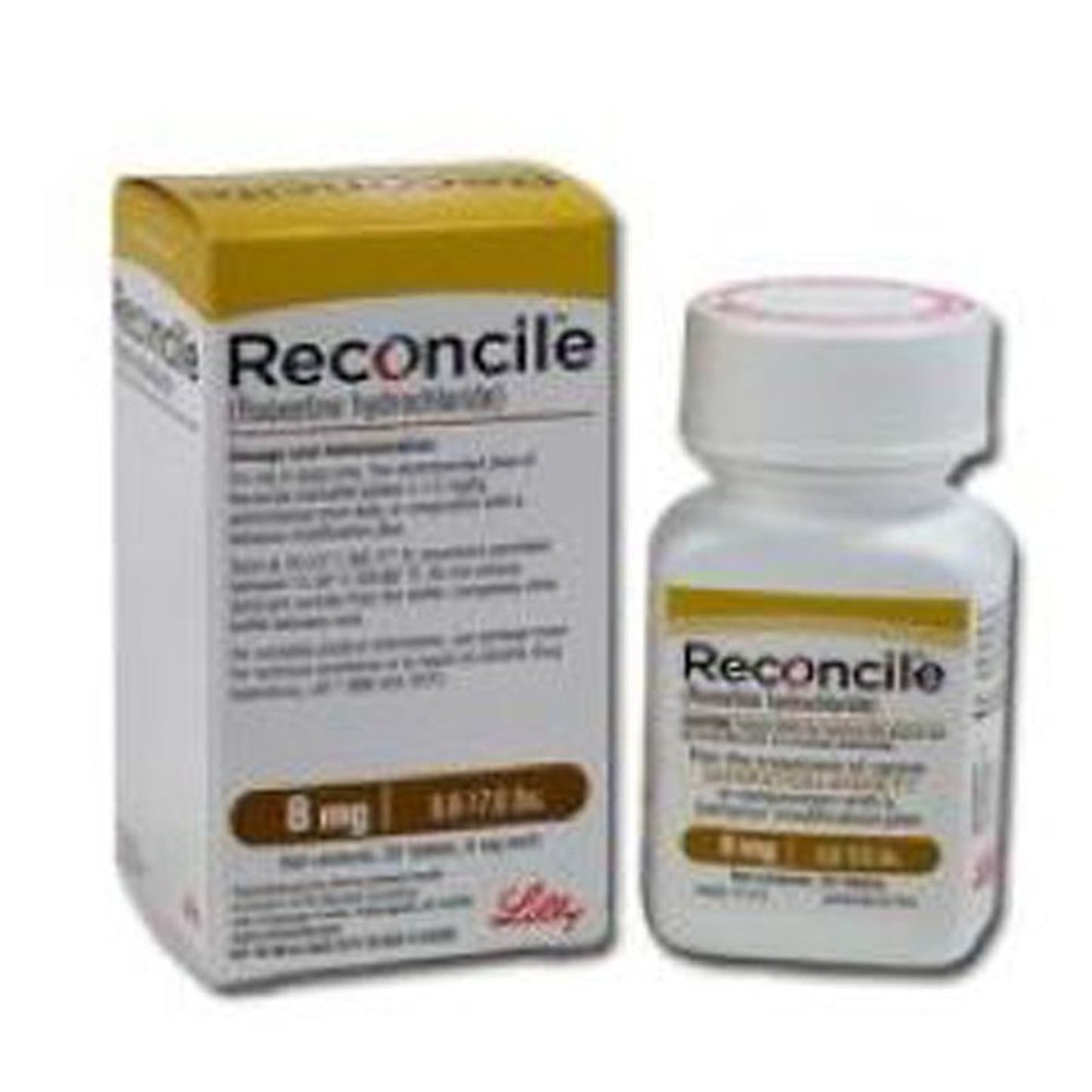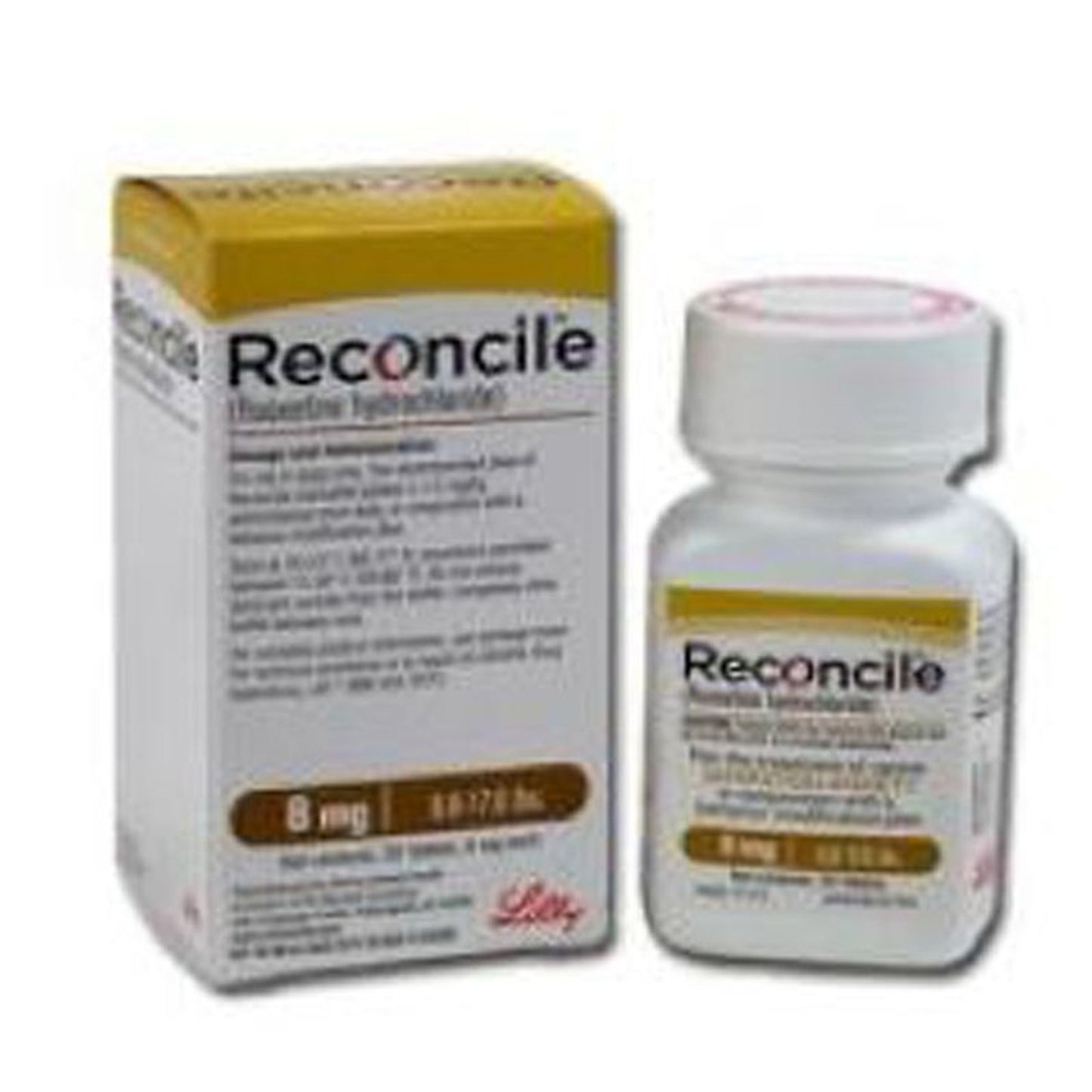KVSupply
Reconcile Chewable Tablets
Reconcile Chewable Tablets
Couldn't load pickup availability
SKU:496166 008
Reconcile Chewable Tablets
(fluoxetine hydrochloride)
Reconcile™ is approved by the FDA to help manage separation anxiety. It's intended for use with a behavior modification plan. Supplied in chewable tablets for easy administration
Item Specifications:
For Use:
Dogs
Stength:
8mg
16mg
32mg
64mg
Size:
30 Count
Manufacturer:
Elanco
Indications:
RECONCILE chewable tablets are indicated for the treatment of canine separation anxiety in conjunction with a behavior modification plan.
Contraindications:
RECONCILE chewable tablets are contraindicated for use in dogs with epilepsy or a history of seizures. RECONCILE chewable tablets should not be given concomitantly with drugs that lower the seizure threshold (e.g., phenothiazines such as acepromazine or chlorpromazine).
RECONCILE chewable tablets should not be given in combination with a monoamine oxidase inhibitor (MAOI) [e.g., selegiline hydrochloride (L-deprenyl) or amitraz], or within a minimum of 14 days of discontinuing therapy with an MAOI.
RECONCILE chewable tablets are contraindicated in dogs with a known hypersensitivity to fluoxetine HCl or other SSRIs. Because fluoxetine and its major metabolite, norfluoxetine, have long half-lives, a 6-week washout interval should be observed following discontinuation of therapy with RECONCILE chewable tablets prior to the administration of any drug that may adversely interact with fluoxetine or norfluoxetine.
Dosage:
Use as Directed by your Veterinarian
Description: RECONCILE is a chewable, flavored tablet that contains fluoxetine hydrochloride. The active ingredient in RECONCILE chewable tablets is fluoxetine hydrochloride, a selective serotonin reuptake inhibitor (SSRI). The molecular weight of fluoxetine is 345.79.
Caution:Federal (USA) law restricts this drug to use by or on the order of a licensed veterinarian.
Human Warnings:
Not for use in humans. Keep out of reach of children. In case of accidental ingestion seek medical attention immediately. In humans, the most common symptoms associated with over dosage include seizures, somnolence, nausea, tachycardia, and vomiting. In case of ingestion by a human, contact a physician immediately. For a copy of the Material Safety Data Sheet (MSDS) or to report adverse reactions call 1-888-545-5973.
Precautions:
RECONCILE chewable tablets are not recommended for the treatment of aggression. RECONCILE chewable tablets have not been clinically tested for the treatment of other behavioral disorders. Studies to determine the effects of RECONCILE chewable tablets in breeding, pregnant, or lactating dogs and in patients less than 6 months of age have not been conducted. Seizures may occur in dogs treated with RECONCILE chewable tablets, even in dogs without a history of epilepsy or seizures (see ADVERSE REACTIONS).
Before prescribing RECONCILE chewable tablets, a comprehensive physical examination should be conducted to rule out causes of inappropriate behavior unrelated to separation anxiety. The examination should include a thorough history and assessment of the patient's household environment and standard practice laboratory tests as appropriate for the patient's age and health status. Veterinarians should be familiar with the risks and benefits of the treatment of behavioral disorders in dogs before initiating therapy.
Inappropriate use of RECONCILE chewable tablets, i.e. in the absence of a diagnosis or without concurrent behavior modification, may expose the animal to unnecessary adverse reactions and may not provide any lasting benefit of therapy.
RECONCILE chewable tablets have not been evaluated with drugs that affect the cytochrome P450 enzyme system. RECONCILE chewable tablets should be used with caution when co-administered with any drug that affects the cytochrome P450 enzyme system (for example, ketoconazole). Studies to assess the interaction of RECONCILE chewable tablets with tricyclic antidepressants (TCAs) (for example, amitriptyline and clomipramine) have not been conducted. The minimum washout period to transition dogs from TCAs to RECONCILE chewable tablets has not been evaluated. Published pharmacokinetic data demonstrates that TCAs are cleared 4 days following discontinuation. 1,2
Adverse Reactions:
In two North American multi-site field studies, which included a total of 427 dogs, the following adverse reactions were observed:
Seizures: In one study, one of 112 dogs in the control group and three of 117 dogs that received RECONCILE chewable tablets experienced the serious adverse reaction of seizures. One of the three dogs treated with RECONCILE chewable tablets experienced two seizures 10 days after the end of therapy.
Despite escalating phenobarbital doses, the seizures continued and this dog died in status epilepticus approximately six months after the first seizure. Another of the three dogs treated with RECONCILE chewable tablets had experienced one seizure approximately 1 1/2 years prior to study enrollment immediately after receiving head trauma.
No additional seizures were reported to have occurred until 45 days after concluding treatment with RECONCILE chewable tablets.
During the 1 1/2-year period since the second seizure, this dog's seizure activity increased from single seizures to cluster seizures despite increasing doses of phenobarbital and the addition of oral potassium bromide and rectal diazepam. The third dog treated with RECONCILE chewable tablets and the control dog experienced one seizure 24 days and 35 days, respectively, after the start of therapy; no anticonvulsant therapy was initiated and no further seizures were reported in either dog.
In the second study, one of 99 dogs treated with RECONCILE chewable tablets and one of 99 dogs treated with the control tablet experienced the serious adverse reaction of seizures 9 and 27 days, respectively, after initiation of therapy. The dog treated with RECONCILE chewable tablets was subsequently diagnosed with vestibular disease and the control dog had a history of recurrent hind leg weakness.
1 Plumb DC. Amitriptyline. Veterinary Drug Handbook 5th Edition (Pocket Edition). Iowa State Press. Ames, IA. Page 39, 2002.
2 Hewson CJ, et.al. The pharmacokinetics of clomipramine and desmethylclomipramine in dogs: parameter estimates following a single oral dose and 28 consecutive daily doses of clomipramine. J Vet Pharmacol Therap 21:214-222, 1998.
In a European multi-site study, 234 dogs were treated with daily doses of fluoxetine chewable tablets ranging from 0.25 mg/kg to 4 mg/kg.
One dog treated with a daily dose of 0.4 mg/kg for one month experienced one seizure one week after discontinuing therapy. No anticonvulsant therapy was initiated and no further seizures were reported.
Clinical Pharmacology:
Fluoxetine exerts its effect by inhibiting the reuptake of serotonin at the pre-synaptic neuron. Fluoxetine does not act as a sedative. Fluoxetine is well absorbed after oral administration (~72%). It is largely metabolized in the liver by cytochrome P-450 enzyme system to norfluoxetine, an equipotent SSRI that contributes to the efficacy of RECONCILE chewable tablets.
In a 21-day study, fluoxetine was administered daily at a dose of 0.75, 1.5 and 3.0 mg/kg to laboratory Beagles. The maximum plasma concentration (Cmax) and area under the plasma concentration time curve (AUC) for fluoxetine were approximately dose proportional between 0.75 and 1.5 mg/kg, with a greater than dose proportional increase at 3 mg/kg. Norfluoxetine Cmax and AUC were generally dose proportional.
Although steady state appeared to be reached within 10 days in the 21-day study, a continuous increase in trough concentrations was observed in a one year, multiple-dose laboratory safety study. In this study, dogs administered a 1 mg/kg dose of fluoxetine had plasma fluoxetine concentrations that continued to increase over the one-year dosing period. A similar increase in concentrations was observed with norfluoxetine. This phenomenon was not observed at higher doses. During the one-year dosing interval and the subsequent two-month recovery period, there were no changes in the nature and frequency of adverse reactions observed as compared to those seen by Day 28 of fluoxetine administration.
Effectiveness:
In one randomized multi-centered, double-blinded, vehicle-controlled study of 8 weeks duration, 229 dogs were evaluated at 34 investigative sites in the United States and Canada. One hundred seventeen dogs were randomized to 1-2 mg/kg/day of RECONCILE chewable tablets and 112 dogs were randomized to the control group. Both groups underwent concurrent behavior modification. In seven of the eight weeks, the percentage of dogs with improved overall separation anxiety scores was significantly higher (p ≤ 0.05) among dogs treated with RECONCILE chewable tablets compared to dogs that received the control tablet. At the end of the study, 73% of dogs treated with RECONCILE chewable tablets showed significant improvement (p=0.010) as compared to 51% of dogs treated with behavior modification alone.
Dogs treated with RECONCILE chewable tablets also showed improvement in destructive behavior, excessive vocalization, and restlessness over dogs that received the control tablet. In addition, dogs in both groups experienced improvement in inappropriate urination, inappropriate defecation, excessive salivation, excessive licking/grooming, shaking/shivering and depression. Overall separation anxiety severity scores improved more rapidly for dogs taking RECONCILE chewable tablets than those dogs receiving the control tablet. The same effect was also noted for the individual scores for excessive vocalization and depression.
Animal Safety:
In a one-year laboratory safety study, dogs were dosed daily at 1, 4.5, and 20 mg/kg/day of a gelatin capsule filled with fluoxetine powder. Based upon the results of a relative bioavailability study comparing the fluoxetine-filled capsule versus the RECONCILE chewable tablets, the corresponding equivalent doses were 0.87, 3.9 and 17.4 mg/kg/day of RECONCILE chewable tablets (where the average ratio of fluoxetine AUC values for RECONCILE chewable tablets/fluoxetine-filled capsule = 1.15).
Three of five female dogs in the 20 mg/kg group, died or were euthanatized during the first six months of the study. The high dose was decreased to 10 mg/kg/day (equivalent to 9.7 mg/kg/day of RECONCILE chewable tablets) for the last six months of the treatment, and all remaining dogs completed the study. One dog in the 1 mg/kg group (equivalent to 0.87 mg/kg/day of RECONCILE chewable tablets) and two dogs in the 20 mg/kg group (equivalent to 17.4 mg/kg/day of RECONCILE chewable tablets) experienced a seizure. Aggressive behavior, ataxia, salivation at dosing, hyperesthesia, nystagmus, thin body condition, weakness, lethargy, diarrhea and head tilt were also noted in the high dose group. Anorexia, tremors, decreased pupillary light response, mydriasis, vomiting, and decreased weight gain were observed in all treatment groups, but occurred more frequently in the high dose group. With the exception of decreased weight gain, all abnormal observations resolved by the end of a two-month recovery period. Evidence of phospholipidosis was noted in the lung, liver, adrenal glands, lymph nodes, spleen, retina and white blood cells of all groups, which resolved during the recovery period. Fluoxetine caused no marked or consistent effects on hematology, blood chemistries or urinalysis. Bradycardia was absent on the electrocardiogram in the control and lowest dose groups, but was mildly present in a dose-dependent manner in the two higher dose groups. There were no effects noted on gross organ examination.
Storage Information:
Store at 20-25°C (66-77°F). Excursions permitted between 15-30°C (59-86°F).
Do not remove desiccant canister from the bottle. Completely close bottle between uses.
NADA #141-272, Approved by FDA
Model Numbers and UPCs
Model Numbers and UPCs
| Style | Item Number | UPC |
|---|---|---|
| 8mg | 496166 008 | 309864203306 |
| 32mg | 496166 032 | |
| 64mg | 496166 064 | 309864209308 |
| 16mg | 496166 016 |
Share




